This article has been reviewed according to Science X's editorial process and policies. Editors have highlighted the following attributes while ensuring the content's credibility:
fact-checked
peer-reviewed publication
trusted source
proofread
Non-invasive device uses magnetoneurography to record involuntary nervous system
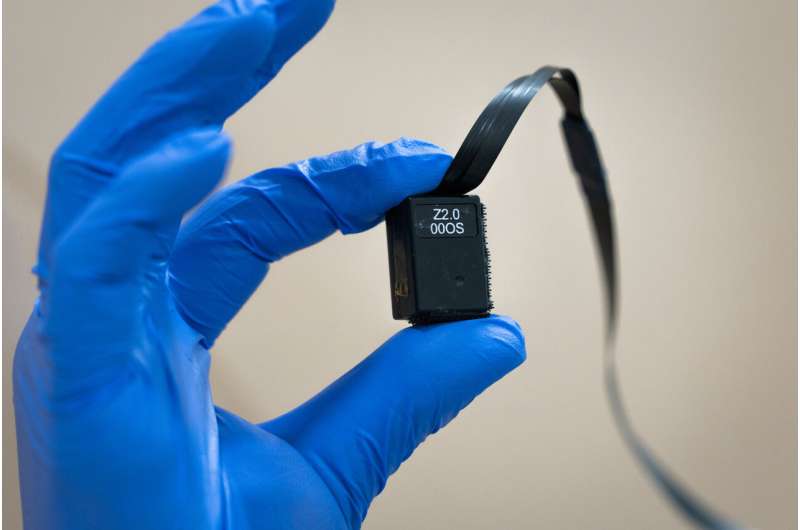
A research team led by UC San Diego has, for the first time, shown that a wearable, non-invasive device can measure activity in human cervical nerves in clinical settings.
The device records what the team calls autonomic neurography (ANG), neural activity from the human vagus and carotid sinus nerves as well as other autonomic nerves found in the skin and muscle of the neck.
The vagus nerve is a "superhighway" of the involuntary nervous system, with tendrils extending from the base of the skull through the torso and abdomen to influence digestion, heart rate and the immune system.
The vagus nerve plays a pivotal role in the body's inflammatory response to injury or infection, and has been a focus for research into deadly conditions like sepsis, a leading cause of emergency room deaths affecting at least 1.7 million adults in the U.S. each year according to the National Institute of General Medical Sciences, and post-traumatic stress disorder, which affects about 3.5% of the population according to the National Institute of Mental Health.
To offer medical professionals a real-time, clinically proven tool for detecting levels of activity in the involuntary nervous system, an early warning sign of a body under stress, the researchers designed a flexible, adhesive-integrated electrode array (as reported in a 2022 Scientific Reports paper).
The current study, published July 29, 2024 in Nature Communications Biology, used this approach with the aim of detecting deep neural activity in a simulated clinical hyperinflammatory model.
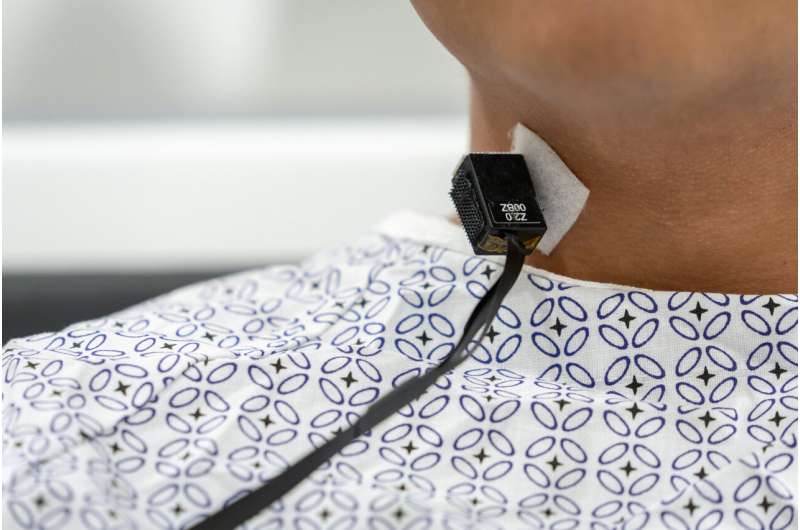
"We are encouraged by our results. The device is poised to provide an early diagnostic marker of pathogen infection, or inflammation from a pathological process," said the study's senior author Imanuel Lerman, head of the Lerman Lab of UC San Diego's Qualcomm Institute, School of Medicine, and Jacobs School of Engineering, as well as the VA Center of Excellence for Stress and Mental Health.
Lerman is the founder of InflammaSense Inc, the company that licenses the device's technology. "Based on the study results, we are now deploying the device at the intensive care units of the Jacobs Medical Center at UC San Diego Health. The device will detect early involuntary neural signaling indicative of impending sepsis."
Troy Bu, a Ph.D. candidate in the Jacobs School's Department of Electrical and Computer Engineering, is the study's first author.
Real-time in the emergency room
To replace surgically implanted microelectrodes to monitor or activate the vagus nerve, the new device leverages a powerful technique called "magnetoneurography" to more accurately detect cervical nerve firing non-invasively in real-time. The device detects the magnetic fields arising from activity in the vagus and carotid sinus nerves, which "pulse" to warn the involuntary nervous system of a threat.
Researchers tested the device in nine adult human subjects. Patients had their blood drawn and their plasma tested for baseline levels of inflammation-triggering proteins called cytokines. Next, they were injected with bacteria-sourced toxins called lipopolysaccharides, inducing a temporary hyperinflammatory state in the body that mimicked the inflammation associated with a blood infection.
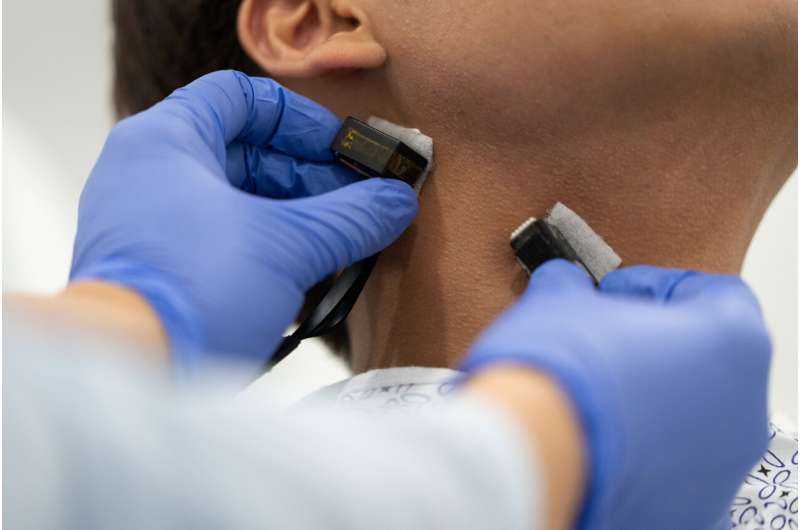
Inside a magnetically shielded room at the UC San Diego Qualcomm Institute Magnetoencephalography Center, researchers placed sensors from their device at points of the vagus nerve beneath the right ear and over the right carotid artery, where both the vagus nerve and carotid sinus nerve are found. The device monitored heart rate and the magnetic fields arising from nerve activity.
Within half an hour of the patients' injection with lipopolysaccharides, the device detected changes in their nerve activity below the right ear.
Researchers confirmed the rise in nerve activity and the release of inflammatory proteins through blood samples. They also recorded changes in heart rate throughout, as well as a noticeable link between nerve firing at both sites and changes in a particular inflammatory cytokine called tumor necrosis alpha, or TNF-α and the anti-inflammatory cytokine called IL-10.
TNF-α is a herald of sorts; patients with high levels are at a higher risk of entering septic shock, a deadly condition where the body's inflammatory response overshoots the mark and causes devastating system-wide effects that can ultimately result in death.
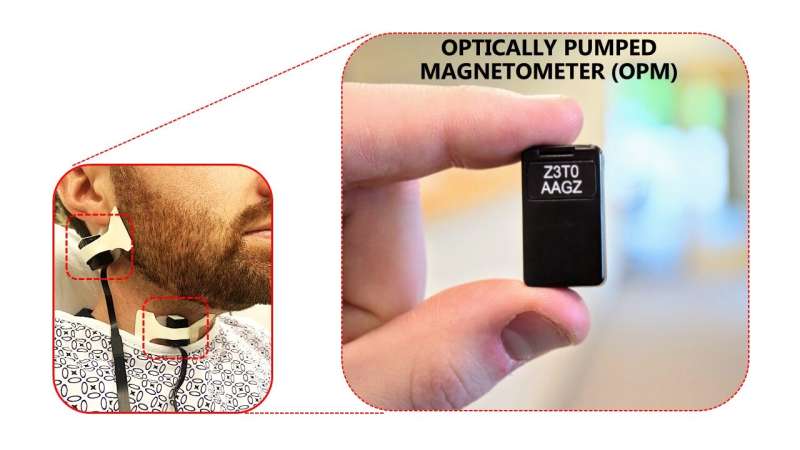
Elevated levels of IL-10, on the other hand, can indicate patients at risk of immunoparalysis, a condition that occurs during sepsis when immune cells are unable to fight off either foreign or resident microbes, or resident viruses that can lead to uncontrolled infection and death.
"With sepsis, every minute counts and early treatments save lives," said Bu. "Early sepsis detection is critical as, every hour sepsis is not treated, the likelihood of death increases by up to seven percent. Our technology can provide doctors with an early warning sign of hyperimmune or immunoparalysis response in sepsis. Doctors can then provide the correct treatment as quickly as possible."
As in the 2022 study, researchers again found that patients separated into groups with distinct responses to the stress of the injection. Some patients showed higher peaks in the presence of inflammatory proteins and stronger side effects, while others' peaks were lower.
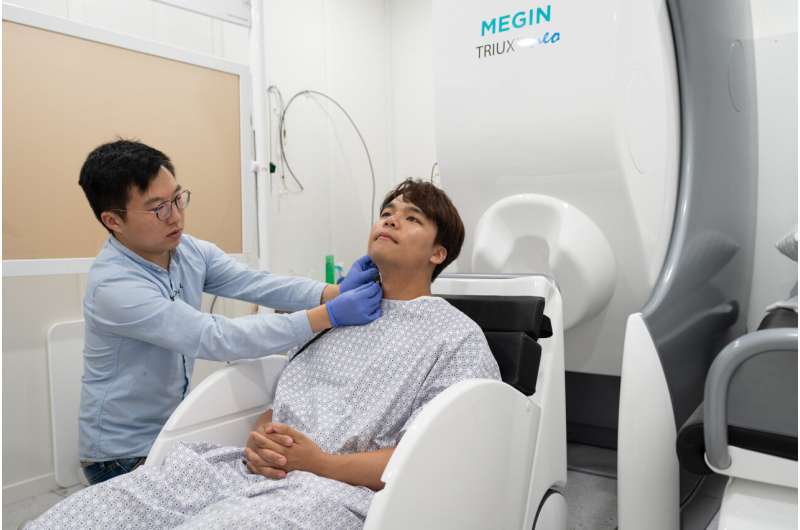
With this technology, doctors may be able to identify subgroups of patients at higher risk of a hyperactive immune response and immunoparalysis, both of which contribute to sepsis-related complications and mortality.
The device may also be used to determine whether treatments are reducing inflammation in the body, to better understand the nervous system and inflammation in people experiencing PTSD and other mental health conditions, and to tailor the dosage of therapies that target individual patients' nervous systems.
This study was a collaboration between UC San Diego, Sandia National Laboratories, the University of Wisconsin-Madison, the VA Center for Stress and Mental Health, Quspin Laboratory, Stanford University and InflammaSense Inc.
More information: Non-Invasive Ventral Cervical Magnetoneurography as a Proxy of In Vivo Lipopolysaccharide-Induced Inflammation, Communications Biology (2024). DOI: 10.1038/s42003-024-06435-8




















